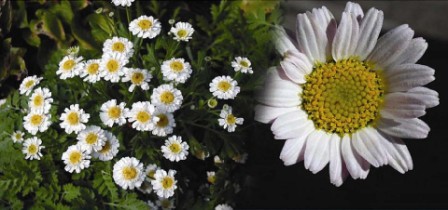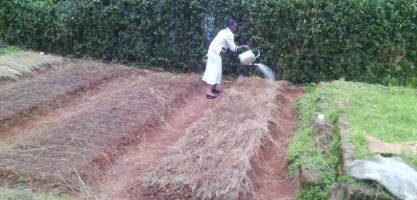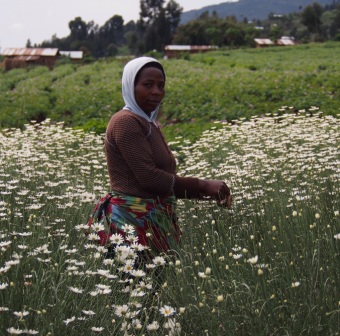Pyrethrum Farming in Kenya
Pyrethrum Farming in Kenya is set to become a multi-billion dollar industry in the near future following the change of its governing laws and regulations and enactment of Pyrethrum Act 2012.
What is Pyrethrum
Pyrethrum (Chrysanthemum cinerariaefolium) is a flower that is grown majorly for extraction of its pyrethrin. Pyrethrin is a product that is used in the manufacture of pesticides and insecticides.

This pyrethrin is found in the seed cases in the yellow part of the flower. When the flower is dried the pyrethrin is extracted using solvents like hexane and sold in the form of an oleoresin commonly refereed to as the pale yellow extract.
Pyrethrins are considered to be very effective because they attack the nervous systems of all insects. It exhibits rapid “knockdown” effect on the insect.
Pyrethrum has advantages over other insecticides in that it is non-persistent in the environment and hence recommended by the World Health Organization ( WHO) for export horticulture and fruit production due to its low Minimum Residue Levels (MRLs).
It is considered to be amongst the safest insecticides for use around food. It is one of the most commonly used allowed non-synthetic insecticides in certified organic agriculture.
History of Pyrethrum Farming in Kenya
Pyrethrum was introduced in Kenya from Europe by white settlers in 1928. Initially it was grown in large-scale farms but nowadays it is widely cultivated by small-scale farmers. Kenyan pyrethrum was of very high quality. It therefore quickly replaced the Japanese pyrethrum on the world market by around 1941.
During the pyrethrum farming hey days in the 1980s and 1990s, the production of the crop increased steadily and Kenya became a global leader in pyrethrum production, accounting for over 70 percent of the global market.
This lucrative sub-sector supported more than 200,000 small-scale farmers, 3,000 workers directly employed by the Pyrethrum Board of Kenya and over 2 million people deriving their livelihood from the industry either directly or indirectly.
The pyrethrum sector became a major foreign earner contributing approximately KSh. 2.1 billion in 1996 but has since declined to Ksh.130 million in 2010
The number of farmers dwindled from 200,000 in the 1980s to 29,000 (June 2009) and the area under the crop dropped from 40,000 ha during the 1980s to 4,000 ha (2009).
Production has also reduced from a high of 18,000 MT in 1981/82 to 462 MT realized 2009/2010 pool year. The producer price range has stagnated at Ksh. 100 to Ksh. 300 per Kg since 2001 depending on the pyrethrin content.
The decline was caused by among other reasons: unfriendly policy and regulatory environment by the Pyrethrum Board of Kenya; unmet demand; mismatch between market requirements and production, farm level issues such as low productivity and profitability, scarcity of planting materials, high costs of production, delayed payments to farmers, and increased competition from synthetics.
Most of these farmers even up to now still complain that the Pyrethrum Board of Kenya owes them millions of shillings that they had taken as loans and their property is still attached.
Pyrethrum Growing Counties (Areas) in Kenya
Pyrethrum is grown in 19 counties in the country namely;
- Nakuru
- Kiambu
- Nyandarua
- Nyeri
- Laikipia
- Meru
- Embu
- Baringo
- Elgeyo Marakwet
- West Pokot
- TransNzoia
- Bungoma (Mt. Elgon)
- Uasin Gishu
- Nandi
- Kericho
- Bomet
- Kisii
- Murang’a
- Nyamira
Pyrethrum Farming Inputs
Pyrethrum is reproduced and propagated by splits/crown division and seed/seedlings through licenced nursery operators and also on individual farmers farms.
The seedlings are grown in a seedbed and when they reach 4 to 5 inches high they are transplanted to the farms. The spacing required for the planting in the main farm is 2 feet ( 60cm) inter- row and 1 feet ( 30cm) from plant to plant ( intra-row)
Recommended Clones and Varieties of Pyrethrum for Growing in Kenya
For high altitude areas the following clones and varieties are recommended
- SB/66/107 Clones
- Ma/71/423 Clones
- Ma/70/1013 Clones
- Mo/74/223 Clones
- L/75/477 Clones
- L/75/487 Clones
- Varieties are P4
For Medium to Low altitude areas the following clones and varieties are recommended
- Ks/75/336 clones
- Ks/70/64 clones
- Ks/75/313 clones
- Kr/74/122 clones
- Varieties: K218, K235
Recommended Fertilizer for Pyrethrum Farming in Kenya
The recommended Fertilizer for Pyrethrum Farming in Kenya is 5g DAP (Diammonium Phosphate) per hole at planting and 250-300kg/ha of TSP (Triple Super-phosphate) per hole after cutting back. Cutting back is done annually near the end of the dry season followed by weeding and earthing up.
Use a table spoon of TSP for every plant when planting. 50kgs of TSP is sufficient for one acre. The fertilizer should be mixed thoroughly with soil in the hole before planting, to avoid scorching the plant roots by fertilizer. Compost manure can also used instead of TSP at the rate of 200 grams per hole.
Manure of 10 ton/ha (a handful per hole) for poor soils 3 months before planting is recommend.
Important pests and their control in Pyrethrum Farming in Kenya
[table id=29 /]
[table id=30 /]
Pyrethrum Farming Climatic Conditions and Ecological Zone
Pyrethrum is best grown in;
Altitude of 1800-3000m above sea level.
A rainfall of above 750mm pa is required.
Loamy volcanic soils with a pH >5.6 are required and are expected to be fertile, deep and well-drained.
The temperature should be less than 180℃ for at least 6 weeks.
Pyrethrum Farming Land preparation
Plough before the onset of rains and make sure you eliminate perennial weeds and parasitic grass that will become a nuisance once pyrethrum seedlings germinate.
Pyrethrum rots when there is too much rain and also dries when there is no rain. So plant when there is normal rain or make sure your land is well drained to eradicate stagnant water.

The clones should be propagated by splitting the mature plants or by planting tissue-culture Raise varieties in a nursery and producing new seedlings. After 4 years, uproot or discard the plants and do crop rotation with cereals such as maize, wheat, oats or barley or grasses such as weeping love grass, guinea grass, Guatemala grass may be used for rotation. If pyrethrum is left in the same field for more than three years, flower yield declines to uneconomical level in subsequent years due to accumulated effect of pathogens, pests and nutrient depletion.
Ideally, an acre should have 22,000 plants and produces approximately 400kgs of dried pyrethrum flowers annually.
Weeding can either be carried out through mechanical or chemical methods.
- Mechanical weeding: With forked implements from the first month after establishment until the crop has fully covered the ground. After 2-3 months, earth up to encourage tillering
- Chemical weeding: Use herbicides e.g. Sencor, Venzar-Sencor-Ronstar
Topdressing of pyrethrum plants tens to induce them to produce other vegetative stems and leaves that are not important to the farmer. What is important to the farmer is the stems with flower buds. So topdressing is highly discouraged. instead spraying of the BoomFlower is recommended. It is recommended that farmers spray Boomflower two weeks before onset of flower and there after in intervals of two months for profuse flowering.
Pyrethrum Flowers Harvesting/Picking
Pyrethrum flowers should be picked once in 2-3 weeks when the white petals (ray florets) are horizontal and about 3 rows of disc florets are open. This is the time the daisies are in full bloom. This is the time the concentration of pyrethrin is at its peak.

Flower harvesting is selectively done by hand. The best picking method is by holding the flower between the first and second finger and then pulling the flower head with the thumb.
Avoid picking flowers with flower stalks because stalks have little pyrethrin and therefore cause reduction in pyrethrin content of the flowers.
Drying of Pyrethrum Flowers
A small scale farmer can dry the flowers by use of the sun. It is less expensive and causes minimal loss of pyrethrin content. However on cloudy weather or when large quantities of flowers need to be dried, artificial methods may be employed. These artificial methods include artificial solar driers.
These solar driers should be used in the right way so as to preserve the pyrethrin content in the flowers. Keep the drying air temperature in the dryer at a maximum of 50℃ to avoid excessive loss of pyrethrins through overheating. During sale of the flowers moisture content should be less than 11%.
Selling of Dry Pyrethrum Flowers
The dry pyrethrum flowers are taken to various designated collection centers in the various growing areas.
The price of dry pyrethrum flowers depends on the pyrethrin content. Different buyers have different parameters they use while determining what to pay the farmer.
The Pyrethrum Processing Company of Kenya (PPCK) previously Pyrethrum Board of Kenya (PBK) pays Ksh. 100 to 375 per kg based on pyrethrins content; whereby the farmer is paid Kshs 100 per every kg of dry flowers on delivery and thereafter a second payment after determination of the pyrethrin content.
HighChem Agriculture pays Ksh. 140 /Kg to the farmer and can rise to over Ksh 220 per Kg as soon as GAP (Good Agricultural Practices) are achieved.
There has been an increase of pyrethrins content in dry flowers from 1.4 to 1.5% in the last few years. The projected national average is 1.9% which is achievable when farmers embrace good Agricultural practices.
Farmers are encouraged to trade in Pyrethrum Farming as cooperative societies since the advantages derived are heavenly as opposed to farming alone.
The Price of Pyrethrum Products and By-Products in the Market
One kg of the product sells at US$ 270 and due to the high demand, the customers always desire to pay up-front once processing is assured.
For every processing of 100 MT of flowers, 1.65 MT of the refined product is produced; refined product, known as pale extract which is mainly exported (80%) and remaining 20% sold to formulators for value addition .
Levels of Pyrethrum Product Portfolio
Pyrethrum Technical Products
- Pyrethrum Powder 1.3% w/w AOAC
- Pyrethrum Grist
- Pyrethrum Extract Crude Oleo-Resin 25% w/w
- Pyrethrum Extract Pale 25% w/w, 50% w/w, 50% w/w AOAC pharma, and Conc. w/w AOAC – for export market
Pyrethrum By-Products
- Vegetable Waxy Resins (V.W.R.)
- Green oils
- Pyrethrum Fine & Coarse Mark (Py-Mack, is a by-product of the pyrethrin manufacturing industry, and is used as cattle feed. Most of the pyrethrins have been extracted, but enough remains that py-mack can be used as cutworm bait, and in treating early attacks of maize stalkborer. Feeding livestock py-mack is also said to reduce incidence of intestinal worms.)
In addition final product, none of the myriad by-products from the factory is a waste material. For example, Pymarc by-product is sold at Ksh. 1,250 per 50 kg bag while sludge is sold at Ksh. 50 per kg. In a nutshell one processing of 100 metric tonnes of flowers earns PPCK over Ksh. 46 million.
End-Use Products by PPCK (Insecticides)
- Pyagro 4EC – Crop protection product
- Pydust 1% – Grain storage product
- Pymos 0.6EC – Adult Mosquito product
- Pylarvex 0.5EC – Larvae stage mosquito product
- Pynet 5EC – Net treatment product
- Pytix 4% – Tick control product.
After value addition the above 3 categories of products confirms that pyrethrum fits well in the economic pillar of vision 2030 as the crop can be converted into a myriad of value added products. Thus, every single product derived from pyrethrum becomes a raw material for other products.
Value Added Pyrethrum By-Products in Kenya by PPCK
PPCK has formulated and registered 6 insecticides for use in public health and sanitation, animal industry and crop protection sub-sectors.
These end use products are more profitable than Pale with Pymos (TM) 0.6EC giving a gross margin of Ksh. 22,000 per kg compared with Ksh. 2,600 per kg from Pale.
The current production of the pyrethrum extracts is inadequate for the Board to venture into mass production of these insecticides.
How different Pyrethrum Product lines can contribute to the revenue from Pyrethrum Farming
Pyrethrum Pale Extract
This is the major product which, accounts for 96% of the business revenue.
Pymarc
Used for animal feeds and accounts for 3% of the sales revenue.
Value added products (End-use products)
There are five end use products developed from value addition whose profitability in relation to the extract (pale) is tenfold. It is currently accounting for 1% of the revenue earned as it is still under market development process.
Traditional markets for pale have remained the same now at the following levels: Americas (20%), Europe (42%), Australia/Asia (21%), Kenya (10%) and rest of Africa (7%).
The Pyrethrum Board of Kenya was split in to two entities after the enactment of the Pyrethrum Act 2013. The two entities are the Pyrethrum Regulatory Authority (PRA) and Pyrethrum Processing Company of Kenya (PPCK). The PRA is the regulatory entity and PPCK is a commercial entity.
Functions of regulatory entity
- Licensing of:
- Commercial nursery operators
- Processors
- Formulators
- Standards setting and quality control for nurseries and processed products
- Statistics
- Register farmers for traceability
- Collect production and processing statistics
- Assist commercial companies with these statistics for export purposes
- Management of Pyrethrum Development Fund
- Formulation of Policies guiding the industry
Functions of Commercial entities
- Promotion of flower production
- Production of Flowers
- Purchase of flowers from farmers
- Processing of pyrethrum flower
- Value addition
- Market pyrethrum and pyrethrum products
- Warehousing
Pyrethrum Researchers in Kenya
- Kenya Agricultural Research & Livestock Organisation (KALRO) at Molo Research Station
- Pyrethrum Regulatory Authority
Pyrethrum Commercial Nursery Operators
- Pyrethrum Regulatory Authority (PRA) farms
- Senju International Ltd
- Highchem Agriculture Ltd
- Private Self help groups
- Farmers Cooperative societies (FCS),
- Individual farmers